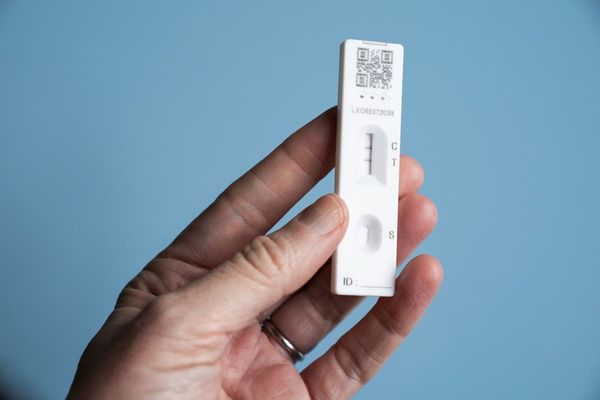When routine COVID-19 rapid tests detected the virus in Emma Missen's two young daughters last month, she was worried.
But as the days in isolation passed, Ivy, 6, and Violet, 8, did not develop any symptoms and their mum said she found it hard to get her head around.
"We've been hiding from it for two years, and this was it," she said.
At the time, there was an outbreak of COVID-19 at the girls' school in Bannockburn, in regional Victoria, and the family had been testing the pair twice weekly.
After it became clear her daughters weren't developing symptoms, Ms Missen asked the school to send home some work for them to do remotely during their seven-day isolation.
"I've got videos of them jumping on the trampoline and having a great time," she said.
The whole family had received all recommended vaccine doses and Ms Missen and her husband were lucky to avoid contracting COVID-19 as well.
Under new isolation rules due to come into effect from September 9, Ivy and Violet would only be required to isolate for five days, rather than seven.
Despite the girls being asymptomatic, Ms Missen said she still would have erred on the side of caution.
"If they were testing negative, I would have been comfortable sending them back to school," she said.
"But that said, on their seventh day of isolation we were meant to be going to a school play where their great-grandmother would have been, and I wouldn't have been comfortable with them being in that setting."
As COVID rules continue changing, more Australian families must navigate decisions around their handling of the pandemic for themselves.
COVID's impact on school, child care and work lessening
Data from surveys taken in April and July this year suggest attitudes to COVID-19 have been changing in Australian homes.
In April, with many restrictions on close contacts still in place, more than 60 per cent of households had a member who had undergone a COVID-19 test in the past month.
That fell to less than 50 per cent by July, despite cases surging as the nation weathered its deadliest month of the pandemic so far.
Of those testing, the proportion recording a positive result was similar, with 27 per cent in the July figures and 23 per cent in April.
Deakin University epidemiology chair Catherine Bennett said the data suggested both that there was some testing "fatigue" and people had learnt to use COVID tests "well".
"It actually tells us that we're starting to adapt to how best to use these tests in the community, and in fact, they are finding positive results," she said.
Other parts of the data reveal trends in line with restriction changes, such as close contact rules — which changed for many in late April.
In April, about 33 per cent of households reported that COVID-19 had impacted school or childcare attendance in the past four weeks, whereas in July, that figure fell to about 15 per cent.
That was lower than the two other surveys taken earlier this year, with the figure of about 23 per cent in March and about 28 per cent in February.
The Missen family's experience reflected the change to close contact rules.
While Ms Missen was able to continue working from home while her daughters were isolating, her husband, in line with the rules, was able to keep working while wearing a mask.
On track for a 'better summer'
July was the peak of Australia's winter wave, with 55,000 new cases reported across the country on July 21, hospitalisations peaking at 5,571 cases on July 26 and 157 deaths marked on July 29.
Professor Bennett said as the wave continued to wane, measures like reducing the isolation period from seven days to five days had been "very carefully balanced around the evidence that we have".
She said a UK study released during the past fortnight provided evidence that 50 per cent of people cleared their COVID infection within five days.
Under the new rules, those showing symptoms will still be expected to isolate, which is designed to help prevent spread as well.
She also said dropping mandatory mask use on domestic flights while some states, such as Victoria, kept mask use mandatory on public transport made sense.
"We know that aeroplanes have actually been remarkably good at managing infection risk, largely because of their already well-constructed ventilation systems," Professor Bennett said.
"You might feel packed in on a plane, but it's not the same as being in standing-room-only public transport at peak hour."
Professor Bennett said waning immunity, the possibility of new sub-variants emerging and the winter experience in the Northern Hemisphere were the key factors that would influence Australia's COVID experience for the rest of 2022.
"We know we usually get two or three months' lead time where we can actually see what might be coming [sub-variants] and actually brace for that," she said.
"We are not seeing that at the moment.
"What happens in the northern winter … and as they pass through autumn, will be really important for us to learn from as well."
Professor Bennett said that, provided the global COVID situation did not take any unexpected turns, it was likely the World Health Organization's declaration of the virus as a public health emergency of international concern would be wound back in 2023.
"If we don't see new sub-variants and we don't see a lot of waning of immunity … then I think we're looking forward to a better summer," she said.










